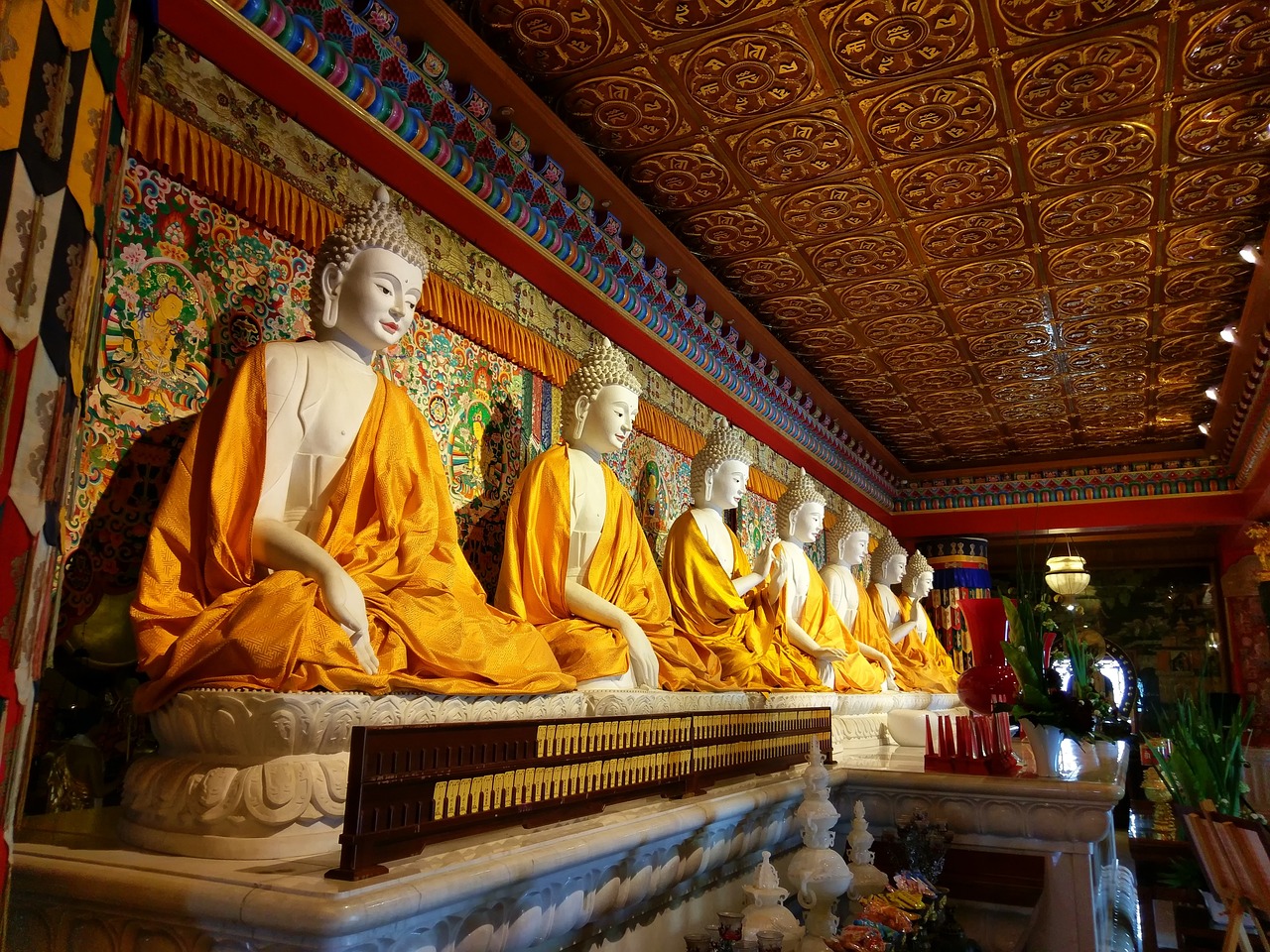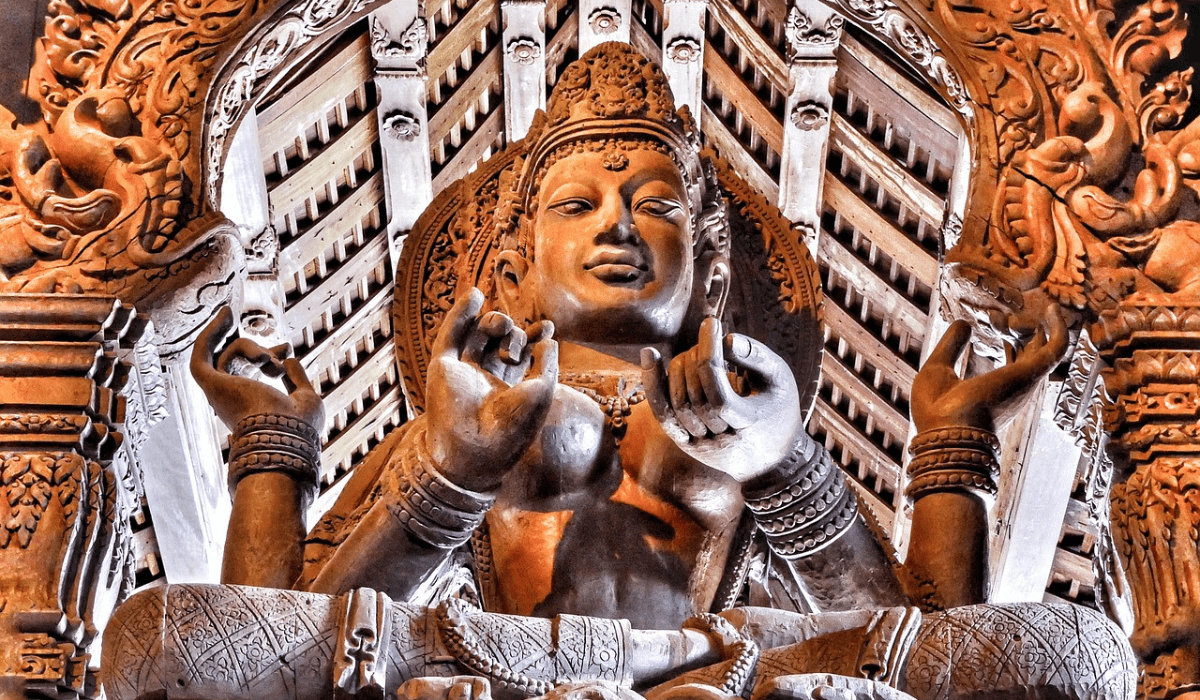During his brief stay in the island, Arahat Mahinda made use of five works of the Pali Canons: Cullahatthipadopama Sutta (Majjhima Nikaya I, 3. 7), Peta Vatthu and Vimana Vatthu, two books of Khuddaka nikaya (short volume) on celestial and ghostly mansions, Devaduta Sutta (on Heavenly Messengers – Majjhima Nikaya III 3. 10) and Balapandita Sutta (on Wise and Fool – Majjhima Nikaya III, 3. 9.).
The whole royal family of King Devanampiyatissa is said to have become Buddhists following these sermons; some family members in fact attained the first stage of sainthood, Sotapanna. Sotapanna is the stream-winner, which literally means entering the stream. He eradicates the first three fetters: belief in an individual self (sakkaya dihi), doubt or uncertainty, especially about the teachings (vicikiccha) and attachment to rites and rituals (silabbata paramaso). The rest go as sensual desire (kamacchando), ill will (vyapada), lust for material existence and rebirth, (ruparago), lust for immaterial existence and rebirth in a formless realm (aruparago), conceit (mano), restlessness (uddhacca) and ignorance (avijja). The sotapanna is named after a simile that compares attaining nibbana with crossing a stream and reaching the farthest shore. Sotapanna, hence, is the first followed by three stages: sakurdagami (oncereturner), anagami (non-returner) and arahant (totally awakened). One sublime reason for the solid establishment of Buddhism in Sri Lanka is arahant Mahinda’s skillful choice of works from the Pali Canons. His mission in sailing for Sri Lanka was more than just converting another royal clan into Buddhism. This fact is clearly corroborated, as the arahant did not get to the conversion business right away; his first requirement was inquiring intellectual capacity of the chief of state with the history’s first recorded famous Intelligence Quotient on trees and relatives. Simile of the elephant footprint with this in the setting, Culla Hatthipadopama Sutta (Majjhima Nikaya: Sutta 27), a minor discourse on the simile of elephant footprints, is an interesting study. Linguistically, Hatthi, Pada and Opama mean elephant, foot and simile respectively in Pali. The source is based on a conversation between two Brahmins (non-Buddhists): Pilotika and Janussoni. Pilotika, though not a perfect Buddhist convert, describes his pleasant feelings about Buddhist philosophy and its followers to Janussoni, making the latter get fascinated in a follow up. An inquiring-minded Janussoni raises the issue of Buddha’s claim to be an Enlightened Being. Simply put, the learned Brahmin questions Buddha’s feat of wisdom, to which Pilotika brings out a simile of an elephant. “… Suppose a wise elephant woodsman were to enter an elephant wood and were to see in the elephant wood a big elephant’s footprint, long in extent and broad across. He would come to the conclusion: ‘Indeed, this is a bi bull elephant.’ So too, when I saw four footprints of the recluse Gotam, I came to the conclusion: ‘The Blessed One is fully enlightened, the Dhamma is well proclaimed by the Blessed One, the Sangha is practicing the good way.’” (Translation by Venerables Nanamoli and Bodhi) The Buddha’s footprints, Pilotika notices, involve the non-Buddhist scholars thinking about raising a particular set of questions and getting armed with rebuttals for obvious answers. Pilotika joyously explains how he sees the same scholars becoming the Buddha’s disciples. Pilotika’s argument is that he has the capacity to measure Buddha’s accomplishment of wisdom by seeing his disciples. Janussoni could be made satisfied by Pilotika’s explanations, but it reflects the modern-day misunderstanding of Buddhism. Buddhism is generally understood as the fact that the true Buddhist stays away from basic sins such as slaughter, stealth, uncelibacy, false speech and alcohol consumption. The core of the teachings, however, is far deeper. Comparing religions Arahant Mahinda’s choice shows the clear difference he wanted to point out between a normal saint and a Buddhist saint. The best way to see the truth is walking from darkness up into light. Janussoni was enlightened when he heard the Buddha’s expanded version of elephant footprint simile. Just because the footprint was large in length and breadth, it does not help picture the big elephant. There can be dwarf female elephants with feet large in length and breadth. Likewise there can be other non-Buddhist saints who stay away from the sins; most sins are listed in the sutta. A big elephant if fathomed only by seeing the whole being. So, the real Buddhist saint should be understood, or the real accomplishment of wisdom should be understood, by the realisation and the practice of four noble truths, originally taught in Buddhism. The sutta is hard to understand in one go. However, if studied carefully, the sutta helps us develop the idea that the modern-day concept of comparing Buddhism with other religions is not theoretically correct. Every religion has its unique features, and so has Buddhism: four noble truths, for one. Although the message seems simple and clear, it is hard to convince it to a run-of-the-mill. It is this background that led, or forced, arahant Mahinda to inquire the intellectual capacity of King Devanampiyatissa to get the message. Many scholars, especially Westerners, entertain the theory that Buddhism encourages only the saintly life. Arahant Mahinda gives the lie to this famous misconception with his subsequent sermons of Peta Vatthu, Vimana Vatthu, Devaduta Sutta and Balapandita Sutta, which mostly discuss the way a Buddhist should behave as a layperson. For instance, Peta Vatthu illustrates the fate of evil-doers and Vimana Vatthu focuses on what the virtuous can await. Heavenly messengers Devaduta Sutta talks of five heavenly messengers we see in our life, but continuously and unknowingly pass over. The five heavenly messengers go as follows:
- A toddler standing and lying with difficulty.
- An old woman or man decayed and bent like the framework of a roof.
- A sick woman or man, immersed in their own urine and excreta, raised by others and conducted by others.
- An offender taken hold by the king and given various kinds of torture caned and whipped.
- A dead woman or man after one day, two days or three days, bloated and turned blue.
Balapandita Sutta teaches how the human beings suffer through their follies, thus encouraging good deeds. The primary reason for arahant Mahinda’s arrival in Lanka is the third council which took place during Emperor Asoka’s regime under the guidance of Ven Moggaliputtatissa. It was a hard task for the emperor to set the background to the third council, but reached the expected fruition. Arahant Mahinda’s emissary role is a result of the third council of Buddhism held during Emperor Asoka’s period. Third council The council in fact remains significant and weighty since it paved way for the establishment of the teachings in nine different countries; hence Arahant Mahinda set foot in Lanka, one of the countries then known as Thambapanni, to establish Buddhism. The background for the third council was created 218 years after the Buddha’s demise, in Emperor Asoka’s regime. Despite his notoriety for military offensives, Asoka turned into a different personality following the encounter with a novice monk. The emperor soon grew interest in the teachings. He channeled a great deal of state funds to the welfare of Buddhism, earning the wrath of powerless brahmins. Brahmins obviously had issues with the upbringing of Buddhism, and they had been scheming for the downfall of Buddhism. One strategy was entering the monk order and living as they desire. This was infiltration, one can say. This strategy proved effective as people became embarrassed and disappointed over the behaviour of some monks. They did not care to assume it was a brahmin strategy to put Buddhism into shame. By this time, it dawned upon the emperor that the Uposatha ceremony, or prescribed purification of monks, had not been performed for seven years. He was interested in continuing the much acclaimed spiritual practice. A monk must confess any discipline breach to another monk according to the prescribed purification procedure. The emperor sent courtiers to let the monk order be informed about his wish. However, a positive response from the genuine monks was hard to obtain. They objected, as the order was impure with heretic monks. Courtiers could not see the spiritual grounds of the objection, and they mistook the objection as acting against the royal decree. Offended courtiers started massacring the monks, but were brought to halt by emperor’s brother who was also a monk. Asoka was disturbed to learn this, and inquired Ven Moggaliputtatissa if he was responsible for what his courtiers had done. Ven Moggaliputtatissa smartly handled the situation enlightening the emperor further on Buddhism; the monk’s main point was that Buddhism is a philosophy that sorts things out by analyzing. Asoka then assigned himself the time-consuming task of interviewing each and every monk to identify their genuine position. A monk failing to provide a satisfactory explanation would be disrobed with a proper layperson’s job as an alternative. At least 60,000 people are said to have been disrobed in the purging process. The path for the third council was thus cleared in the 17th year of Emperor Asoka’s period.
Source of this article
Article written by,
Mr SACHITRA MAHENDRA
Published in the Daily News Paper on 22 June 2024 under “Editorial” (Page 04)




